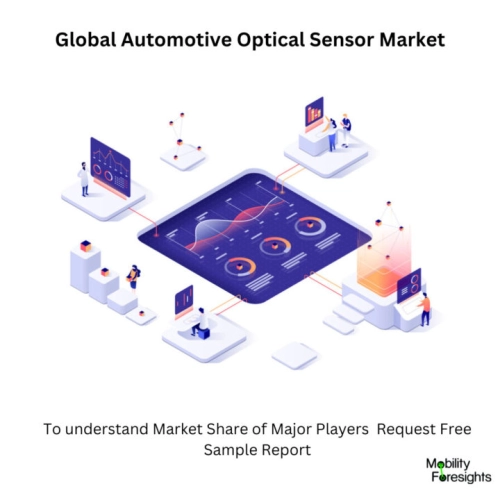
- Get in Touch with Us

Last Updated: Apr 25, 2025 | Study Period: 2024-2030
Infrared photons are converted into electronic signals by an optical sensor. This item often weighs little and offers a number of advantages like compactness, flexibility, and adaptability.
Light rays are transformed into electronic signals by an optical sensor. It measures the actual amount of light and converts that measurement into a format that can be read by an instrument.
An optical sensor typically functions as a component of a larger system that also includes a light source, a measurement device, and the optical sensor.
Optical sensors can be used for a variety of tasks, such as simple distance sensing, giving artificial vision, and developing object identification systems.
Based on the detection of modulated light, infrared sensors can also be used to gauge distances.

The Global Automotive Optical Sensor Market accounted for $XX Billion in 2023 and is anticipated to reach $XX Billion by 2030, registering a CAGR of XX% from 2024 to 2030.
A Pico NC+® optical sensor kit is made available by Pico Technology for NVH balancing applications. Today, Pico Technology unveiled the TA497 Pico NC+ optical sensor as part of the new PQ316 Pico NC+ optical sensor package.
With all the user-friendliness advantages offered by Pico Technology's PicoBNC+ smart interface technology, the new optical sensor kit gives users a practical way to capture rotational speed reference signals for Noise, Vibration, and Harshness (NVH) balancing applications.
The NVH kits from Pico Technology identify vibrations that are related to engine (RPM), propshaft, and road speed and may be brought on by an imbalance in the rotating components or by other circumstances.
To detect propshaft (drive shaft) vibrations, the PQ316 Pico NC+ optical kit can be used in conjunction with an NVH kit and a Pico NC+ Automotive PicoScope.
In these circumstances, rebalancing the propshaft while it is still attached to the vehicle can be much quicker and less expensive than removing and replacing it.
Other rotating objects can also have their speeds measured using the PQ316 Pico NC+ optical sensor kit. Propshaft balancing is accomplished with the use of their PicoDiagnostics software, which leads users through a guided process to assist them in promptly identifying and resolving imbalance.
| Sl no | Topic |
| 1 | Market Segmentation |
| 2 | Scope of the report |
| 3 | Abbreviations |
| 4 | Research Methodology |
| 5 | Executive Summary |
| 6 | Introduction |
| 7 | Insights from Industry stakeholders |
| 8 | Cost breakdown of Product by sub-components and average profit margin |
| 9 | Disruptive innovation in the Industry |
| 10 | Technology trends in the Industry |
| 11 | Consumer trends in the industry |
| 12 | Recent Production Milestones |
| 13 | Component Manufacturing in US, EU and China |
| 14 | COVID-19 impact on overall market |
| 15 | COVID-19 impact on Production of components |
| 16 | COVID-19 impact on Point of sale |
| 17 | Market Segmentation, Dynamics and Forecast by Geography, 2023-2030 |
| 18 | Market Segmentation, Dynamics and Forecast by Product Type, 2023-2030 |
| 19 | Market Segmentation, Dynamics and Forecast by Application, 2023-2030 |
| 20 | Market Segmentation, Dynamics and Forecast by End use, 2023-2030 |
| 21 | Product installation rate by OEM, 2023 |
| 22 | Incline/Decline in Average B-2-B selling price in past 5 years |
| 23 | Competition from substitute products |
| 24 | Gross margin and average profitability of suppliers |
| 25 | New product development in past 12 months |
| 26 | M&A in past 12 months |
| 27 | Growth strategy of leading players |
| 28 | Market share of vendors, 2023 |
| 29 | Company Profiles |
| 30 | Unmet needs and opportunity for new suppliers |
| 31 | Conclusion |
| 32 | Appendix |